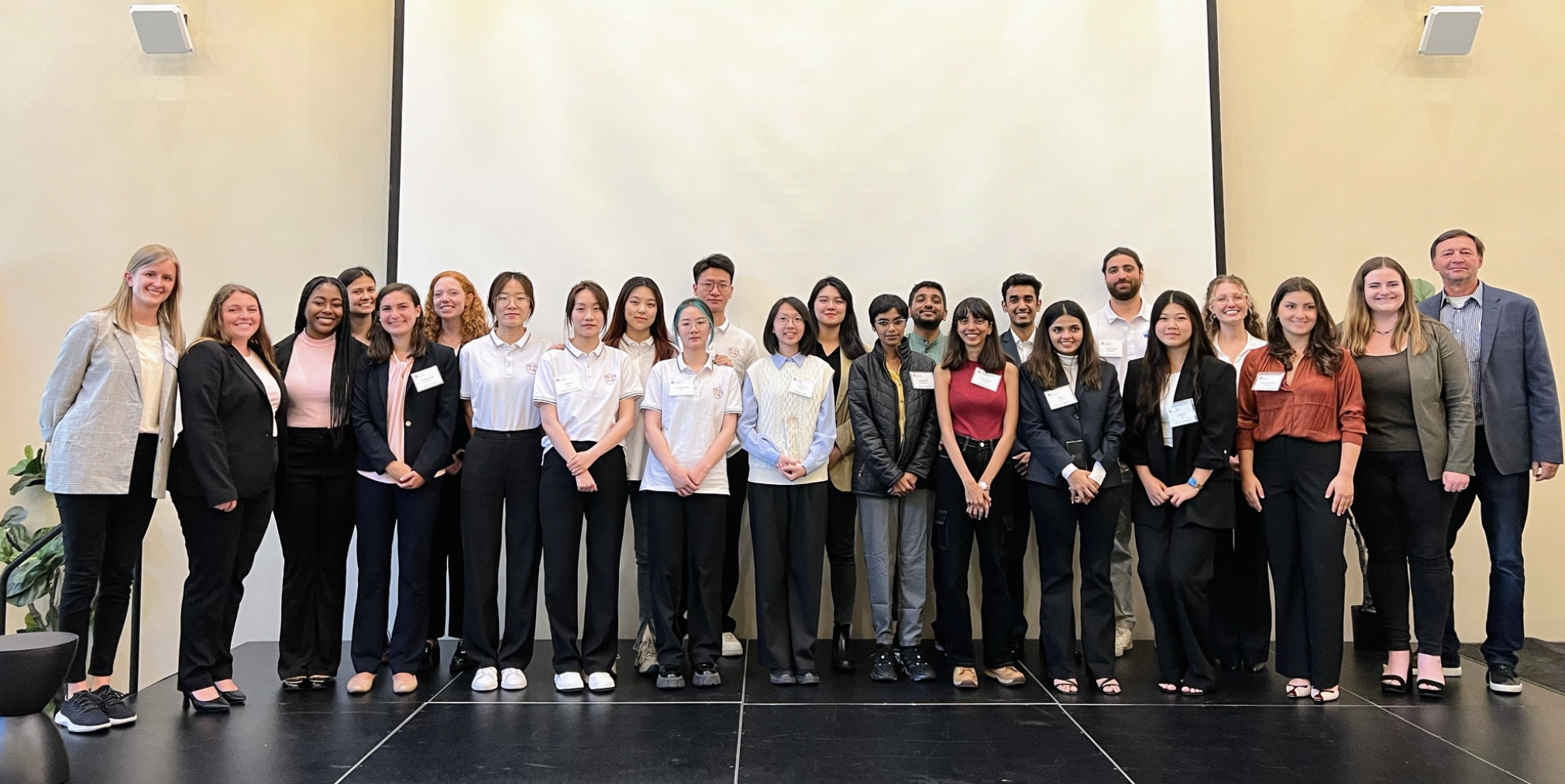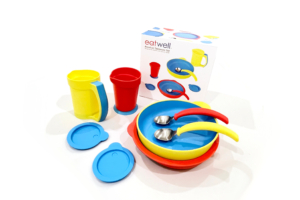Stanford Center on Longevity Design Challenge
A Decade of Global Student Innovation

Marie Conley-Smith (far left) and Ken Smith (far right) with 2022-23 Design Challenge Finalists
More than a decade ago, Sha Yao was struggling with the sorrow of seeing her grandmother descend into dementia. Among the challenges her grandmother faced was increasing difficulty with feeding herself. So Yao, who lives in San Francisco, set herself to solving the problem.

Eatwell assistive tableware set
She designed a set of innovative tableware that allows older people to eat independently. The tableware features high-contrast colors, specially curved spoons, slanted bottoms, deep chambers, and an anti-tip design. But she was having trouble moving from prototype to mass production.
Winning the Stanford Center on Longevity’s first Design Challenge in 2014 catapulted her concept into the stratosphere. Her Eatwell dinnerware was featured in the Cooper-Hewitt Smithsonian Design Museum in 2018 and is available for purchase on Amazon. It has direct distributors in the U.S., Canada, Taiwan, Hong Kong, Macau, South Korea, and Indonesia. “Winning that this award gave me a lot of confidence to continue my work,” she recalls. “I was able to grow rapidly in just a few years, and I’m very grateful.”
“The designer is just one person in the whole blueprint. If you want to make changes, one person is not good enough. By coming [to the Design Challenge], you will make connections with other people. You’ll get to learn about much more, including the research, and how can you really make your business into the real life.” – Sha Yao, CEO of Eatwell, innovative tableware that allows older people to eat independently, and 2014 Design Challenge 1st prize winner.
Ten years ago, SCL initiated the Design Challenge as a way to encourage students in a wide range of fields to think about seeking solutions for issues related to aging. The idea was to throw down the gauntlet and offer a prize – as a means of inspiring students just launching their careers to look at their own communities and identify longevity challenges and to consider how they might solve for those concerns.
A decade later, SCL now awards a $10,000 grand prize each year for the best submission. More than $250,000 has been awarded in prizes, and students from 69 countries have submitted more than a thousand ideas – many of which have been developed into valuable products that support healthy longevity.
SCL’s goal for the Design Challenge has always been primarily educational, to stimulate students to consider and re-frame the problems of aging. Participants must both identify specific challenges to long, healthy lives – and then create elegant solutions. The challenge aims to encourage new ideas from longevity findings in different places, with an understanding that local knowledge is essential to generating appropriately designed solutions, and with the hope that young designers might be inspired to work in the longevity field.

Challenge Founder, Ken Smith
Ten years ago, says SCL Director of Programs and Design Challenge founder Ken Smith, the opportunities created by an aging society were not part of any mainstream conversation. “A lot of the articles about population aging started with what a disaster it’s going to be,” he recalled. “That was never the approach of the Center on Longevity. This is one of the great accomplishments in human history. We wanted to do something that would engage younger people in understanding that this change is about not just older people, but it’s about them as well. And not only is it a change, but it’s an opportunity.”
Professor Ricardo Gomes, a professor at San Francisco State University’s School of Design who moderated a panel at the most recent Design Challenge gathering, said his students used to talk about aging as if it were a disease, but SCL has upended that paradigm. Moreover, he said, SCL includes critical questions in its design criteria that raise awareness that the benefits of longevity are not equitable. “Is that affordable? Who’s going to benefit from that?”
“Design is not about the object,” says Gomes. “It’s not about the gadget or the device. It’s about the experience. How does that design enhance the lifestyle, the lifespan, the longevity that we all cherish? That’s the real key.”
Initially, the Design Challenge was more tightly focused around traditional ideas of aging and longevity, with most submissions focused on problems of old age. But after the launch of SCL’s New Map of Life initiative, which identifies lifelong factors that contribute to healthy aging, SCL began intentionally broadening the competition’s annual design themes. SCL wants submitters to think more inclusively about how challenges throughout life are longevity-related, and how solutions that address people throughout their lives can lead to healthier old age.
In awarding prizes, SCL believes it is essential to provide an equal playing field and consider submissions from around the world. SCL is interested in identifying global longevity issues within local contexts and supporting appropriate and accessible solutions. The judges look not for the flashiest designs, but instead pay attention to whether teams have identified a specific target audience with a demonstrated need. The focus is on uncovering helpful, feasible, and affordable solutions for specific markets rather than promoting high tech, expensive projects that are out of reach for most of the globe.
“Designing for longevity means vastly different things in different places,” says Smith, who added that he’s been astounded by the global response to the competition. “We have gotten to see so many things that have made us understand that how you age in New York and Tokyo and Beijing or rural China or in Africa are very different things.”
In 2020, for example, the Design Challenge winner was a team from Bangalore, Daksha Dixit and Kavya Murugan, who used their knowledge of local folklore to create an innovative inducement for parents to get their children vaccinated. Traditionally, newborns are given a beaded bracelet that is worn to ward off the evil eye. The design team suggested that doctors offer an additional bead for the bracelet each time a child receives a vaccine. It was a simple, inexpensive intervention that built on deep knowledge of the local culture.
Another good example was submitted in 2021, when the world had shifted overnight to virtual learning. Nigerian students John Onuigbo and Kyrian Obikwelu created Foris Labs, which focuses on the need for remote education to reach places far from traditional schools. The team designed an interactive virtual science lab that allows students to conduct science experiments individually and in groups. It is particularly useful because it doesn’t require ongoing connectivity. The virtual lab requires a one-time download of a small file, and then it can be used without internet access – a huge benefit in a country like Nigeria, where access is often unavailable. The longevity connection? Evidence shows that education is a critical indicator for longer, healthier lives. Since winning the Design Challenge, Onuigbo has raised $30,000 in initial funding.
“When it comes to designs for longevity, there are three pillars,” says Onuigbo. “Number one is that it needs to be very affordable, and number two, there needs to be visibility. And number three, there needs to be equitable access. The beautiful thing about these three pillars is that they are intertwined. If you’re able to keep the costs low, you’re able to provide equitable access. And if you’re able to provide equitable access, at the end of the day, longevity becomes something that’s very achievable.”
A similarly elegant solution was created by Sa’id Yahaya Hamza, Maryam Bashir, and Muhammed Shuwa Musa in 2022 for a problem they identified in Lagos. There, motorized tuk-tuks are a primary means of transportation and most drivers have smart phones – but the riders do not. The design team’s concept was to use existing infrastructure to create a ride-hailing mechanism. They put buttons on the city’s light posts that can be used to summon a tuk-tuk. The benefits? Greater mobility for the riders and reduced emissions for the community – both of which have strong longevity benefits. (Pollution, for example, leads to greater asthma rates, which leads to reduced life expectancy.)
“No solution is insignificant in terms of idea and no idea is too insignificant to make an impact.” – Sa’id Yahaya Hamza, designer of The Sarewa, a ride hailing system for riders without a smartphone, and 2022 Design Challenge 1st prize winner.
Some of the winning submissions have also been for physical devices. The 2023 prize-winning design was for mechanical device that helps people recover from injuries and maintain and develop their balancing skills. Created by Gustavo Ghavami from the Pratt Institute and Carleigh McFarlane from New York University, the Variable Reactive Board addresses the fact that balance is essential for ensuring proper musculoskeletal alignment, maintaining mobility, and optimizing health spans. To use the device, a person stands on a platform that pivots around its center point to shift the user’s center of gravity. The device addresses a significant need for healthy aging. Falls among adults 65 and older caused over 34,000 deaths in 2019, making it the leading cause of injury death for that group, and the CDC recommends balance training as a key fall prevention tool.
“Participating in the challenge gave us the opportunity to interact with fellow designers from around the world and receive mentorship on everything from our pitch deck to our business plan. We were connected with people who we would never have had the opportunity to meet living in NYC.” – Carleigh McFarlane and Gustavo Ghavami, designers of Variable Reactive Board, a balance training device, and 2023 Design Challenge 1st prize winners
Justin Boogaard competed in 2017 with an interface called GoGoGrandparent that helps seniors without access to smart phones use ride-sharing apps. It is now integrated with Uber and Lyft. And Kyle Rand won 2nd place in 2017 for Rendever, a virtual reality platform that gives older adults shared and otherwise inaccessible experiences. Rendever can be found in senior living facilities across the U.S. and was awarded a $2 million NIH grant to research the impact of virtual reality on the aging population.
The biggest measure of the Design Challenge’s success is how many submissions are received, because the goal is inspiration and education. And for the participants – the highest value they identify is the connections they make while participating. They become part of a global community of researchers who are imagining longevity issues in new and mutually supportive ways. They form friendships, find mentors, generate new ideas for research, and even get help in launching and promoting new products.
